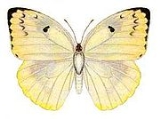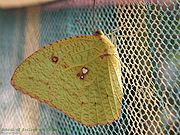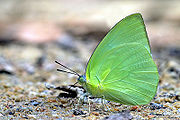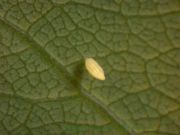
Catopsilia pomona
Encyclopedia

Pieridae
The Pieridae are a large family of butterflies with about 76 genera containing approximately 1,100 species, mostly from tropical Africa and Asia. Most pierid butterflies are white, yellow or orange in coloration, often with black spots...
butterfly
Butterfly
A butterfly is a mainly day-flying insect of the order Lepidoptera, which includes the butterflies and moths. Like other holometabolous insects, the butterfly's life cycle consists of four parts: egg, larva, pupa and adult. Most species are diurnal. Butterflies have large, often brightly coloured...
found in Asia
Asia
Asia is the world's largest and most populous continent, located primarily in the eastern and northern hemispheres. It covers 8.7% of the Earth's total surface area and with approximately 3.879 billion people, it hosts 60% of the world's current human population...
and parts of Australia
Australia
Australia , officially the Commonwealth of Australia, is a country in the Southern Hemisphere comprising the mainland of the Australian continent, the island of Tasmania, and numerous smaller islands in the Indian and Pacific Oceans. It is the world's sixth-largest country by total area...
. The species gets its name from its habit of migration. Some early authors considered them as two distinct species Catopsilia crocale and Catopsilia pomona.
Description
-_male_on_jatropha_panduraefolia_in_kolkata_iws_img_0225.jpg)
The species has pale and dark morphs in Australia. The form crocale has the antennae black and the form pomona has the antennae pinkish or red. The development of these forms has been linked to photoperiod and temperature
Temperature
Temperature is a physical property of matter that quantitatively expresses the common notions of hot and cold. Objects of low temperature are cold, while various degrees of higher temperatures are referred to as warm or hot...
during growth.
The following description is from Bingham for Catopsilia crocale:
The upperside of the male is chalky-white, sometimes with a more or less broad and clearly defined basal sulphur-yellow area on both fore and hind wings; this sulphur-yellow colour is at times diffused over the whole surface of the wings, though generally it becomes paler towards the terminal margins. For the fore wing, the whole, or sometimes only the apical half, of the costa narrowly black, this color widened out irregularly at the apex; termen widely black at the apex, the colour narrowed posteriorly. This border in some specimens almost reaches the tornus, in others terminates above vein 4; occasionally it is continued posteriorly by a series of block dots at the apices of the veins. Hind wing: generally uniform, unmarked, some specimens bear minute black dots at the apices of the veins.

-_female_at_kolkata_iws_img_0269_.jpg)
-_female_in_hyderabad,_ap_w_img_9976.jpg)
The underside varies from white with a light yellowish sometimes ochraeeous tinge to deep chrome-yellow; markings as in the male but still more variable; in var. catilla the spot at the apex of the cell in both fore and hind wings is enlarged into a large reddish blotch, the similar spot on tho hind wing is sometimes so enlarged as to occupy the apex of the cell, the basal two-thirds of interspaces 4, 5 and 6, and the middle third of interspace 7; in some specimens it is continued posteriorly in a series of obscure lunules to interspace 1a. Antennae red, obscurely dotted with black, palpi and head above red, thorax clothed with long yellow, sometimes greenish hairs, abdomen pale yellow; beneath: palpi and thorax pale to dark yellow, abdomen white.
Lifecycle

Other host plants include Butea monosperma
Butea monosperma
Butea monosperma is a species of Butea native to tropical and sub-tropical parts of the Indian Subcontinent and Southeast Asia, ranging across India, Bangladesh, Nepal, Pakistan, Sri Lanka, Myanmar, Thailand, Laos, Cambodia, Vietnam, Malaysia, and western Indonesia...
, Cassia fistula, Bauhinia
Bauhinia
Bauhinia is a genus of more than 200 species of flowering plants in the subfamily Caesalpinioideae of the large flowering plant family Fabaceae, with a pantropical distribution. The genus was named after the Bauhin brothers, Swiss-French botanists....
spp., Pterocarpus indicus, Senna alata
Senna alata
Senna alata, the Candle Bush, is an important medicinal tree as well as an ornamental flowering plants in the subfamily Caesalpinioideae. It also known as a Candelabra Bush, Empress Candle Plant, Ringworm Tree or "candletree"...
and Sesbania
Sesbania
Sesbania is a genus of flowering plants in the pea family, Fabaceae and the only genus found in Tribe Sesbanieae. Notable species include the Rattlebox , Spiny Sesbania , and Sesbania sesban, which is used in cooking...
species.

Thomas Reid Davys Bell
Thomas Reid Davys Bell , born in Bandon, Cork, was a lepidopterist and forest officer in India.Thomas was the youngest in a family of twelve. His early education was in Dresden. He tried to get into the Indian Civil Services but failed. He later wrote entrance exams to Sandhurst and Woolwich,...
as "The head is round , green, the clypeus edged with brown, covered with small shiny black tubercles which... do not hide the colour of the head; the anal flap is rounded, but looks square at the extremity, and is covered with rows of small black tubercles... of which only the row along the spiracular line is conspicuous. The spiracles are oval, shiny and white. The colour is green with a spiracular white band touched with bright yellow on segments 2-5, and these segments, especially 3 and 4, are distinctly flanged on the spiracular line.


